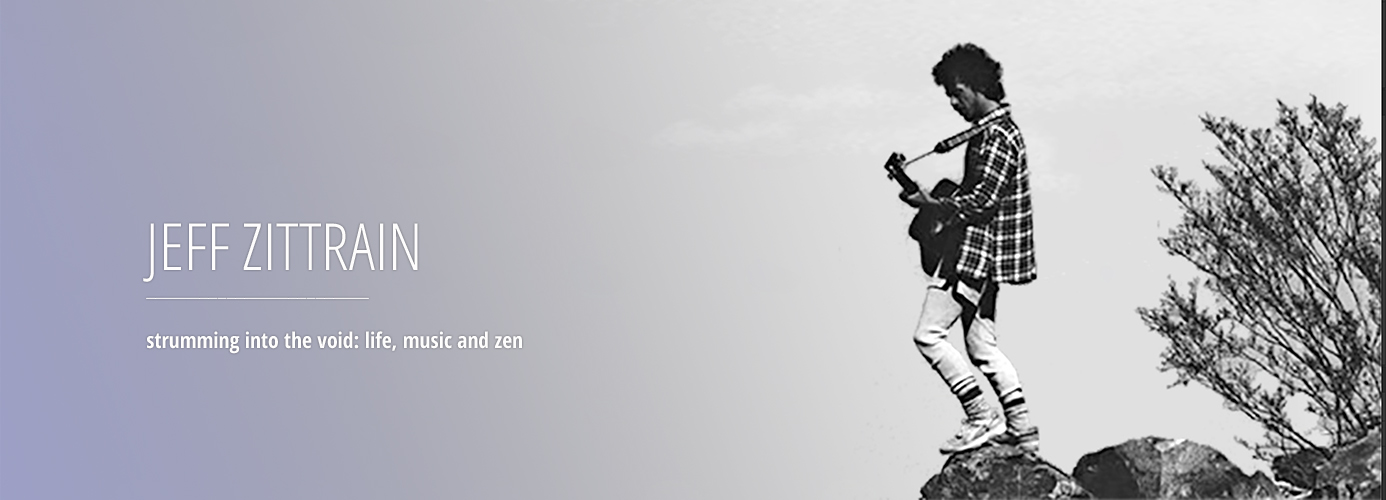Viva Santana! Every Step of the Way to Childhood’s End
First Published in Kynd Music July 2008
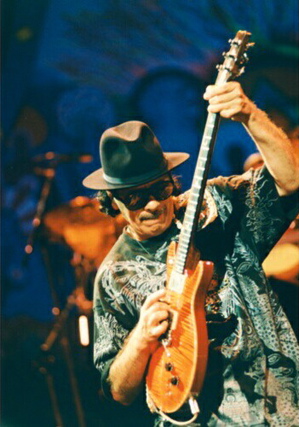
Back in March of this year I answered a Craigslist posting for a “guitar player needed for a Santana jam.” I heard back from a bass player who checked out my website, decided I passed muster, and then sent me a list of 32 (count ‘em!) Santana songs. Daunting, yes, but I figured with keyboards filling out the sound I could fake my way through about half of the list and hang back and let another guitarist carry the weight on the others. One week before the jam I got an email that I would be the only guitar player there.
Instead of freaking out – or more accurately, along with freaking out, it became a musical mission for me and a point of pride. Could I carry a jam centered around one of the most significant, recognizable, chop-meister guitar players of all time?
Here is where the speedworld of our brave new technology answered my call.
I had heard about 20 of the songs on the list, but most of my Santana was on cassette or vinyl from back in my halcyon high school days. So I trucked off to the used cd stores and found a few of the reissued cd’s, now augmented with bonus (alternate or live) tracks, and then downloaded the others from iTunes. I was having a tough time editing them all to try to fit on one 70 minute cd for my car when I realized I could simply compile them on a playlist that would be unfettered by time constraints – on my iPod – which I’d recently hooked up, 007-style, to my car stereo.
I could now listen to the entire 32-song set (plus alternate versions) in my car, jumping from song to song as needed, and also listen at my computer, guitar in hand, jumping to any place in any song. The days of bulky records and rewinding tape felt as far away as Tom Edison’s crackling gramophone.
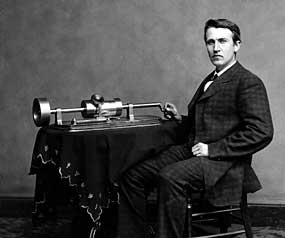
I also found accurate guitar tab on the internet for about 10 songs – and then spent some enjoyable hours into the night scouring YouTube to watch about 10 others.
Bear in mind, none of this would have have been possible even 3 years ago.
Looking back, my progress was pretty stunning – I started on a Monday sitting at my computer with my acoustic guitar playing the rudimentary licks of the songs and by Friday I was ripping through solos on my SG with my practice amp by my side. I felt like Bill Murray learning to play the piano in one (long) day in Groundhog Day.
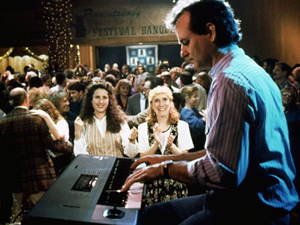
It also reminded me of Arthur C. Clarke’s famous sci-fi novel Childhood’s End which we had to read in high school English class about the same time I was buying my Santana on vinyl or taping it from my friends’ older brothers. From what I remember of that book (I would have probably paid more attention if it was not competing with all of that Santana…), the basic idea was that humankind was undergoing a quantum leap to its next stage of evolution.
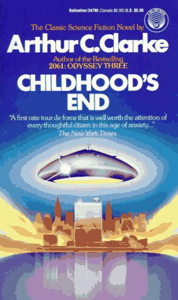
Which is what all of this technology is making us do – when a generation has all of this material literally at its fingertips – videos, songs, tabs, reviews, alternate versions, bonus tracks – all immediately without leaving home, or hell, even getting up from your chair – you learn at an unprecedented lightning-fast exponential rate.
To what end, though, as Arthur C. Clarke asked…
Let’s start with looking at how I learned – I discovered that it was best for me to begin by casting my net wide, as big and non-specific as possible. My first step in tackling that massive list was simply figuring out which album each track was on, which, in the age of Google, took all of about 3 minutes. After my trip to the cd stores and iTunes, the music kicked in at the most basic level – can’t get much more basic than simply getting the key of every song and the scale Carlos was using to solo (sometimes this was a little more complicated if he was playing in a less common mode) – but again, my net stayed wide – before I put much work into any lick, I got every single key and solo mode, all 32.
I’d then learn a little at a time, starting with each basic riff or chord progression. I could then play through the song and tweak it to learn another ornamentation. This was much better than picking a song and trying to learn it straight through. With the jam rapidly approaching, I wanted to feel that I knew enough to at least make it through any song at any time, and was simply refining and refining…Of course, Santana is an ideal band to do this with, as a lot of their music was created in just this way – as riff-oriented or 2-chord jams that got refined bit by bit. (Frank Zappa famously mined quite a few yucks out of this compositional approach with his song Variations on the Carlos Santana Secret Chord Progression on Shut Up and Play Yer Guitar)
Still, I was a little nervous the night before the jam and returned to the cd stores in hopes of finding Welcome, one of the more obscure cd’s that had eluded me last time. While there I stumbled across their 1993 dvd Sacred Fire: Live in Mexico so I snagged that and, instead of practicing, watched it when I came home.
Which was more helpful than practicing. Because while I had been learning the licks pretty close to the released versions, studio and live, I could see here how much Carlos was continually playing variations on the themes. I always knew he did that, but watching it while thinking about my rapidly approaching jam, seeing how he had evolved over 25 years, it freed me up from worrying about everyone else expecting me to nail everything like the record. As far as they knew, I could be quoting from a live jam from some show they hadn’t heard (in which for some mysterious reason he was playing a lot like me …)
Speaking of more obscure shows, that same night I found Lotus, a 2 cd-set from a 1974 live show in Japan that was previously only available as an import. Apparently it was such a transitional “jazz” approach to the music that either the record label or Carlos himself worried that Santana fans would not know how to take it. I can understand the concern – it is raw and even reminiscent of Sun Ra – type noise at times (most notably in an awesome version of Incident at Neshabur.) A few years later, in 1977, the half-live Moonflower (with some personnel changes) was officially released and it is the epitome of slick and clean, from its gorgeous cover to its pristine recording. It’s still a monsterhouse of power, though, and still my favorite Santana album, but not as experimental as Lotus in which you can hear Carlos and the band stretching and searching more.
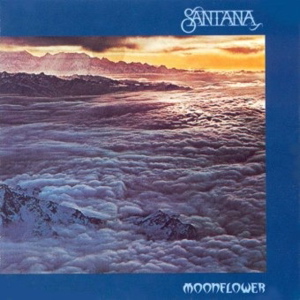
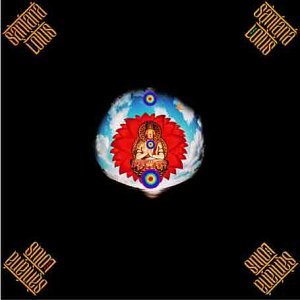
Getting this deeply into one artist was quite the learning experience. The third Santana album (in a strange lapse of titling creativity simply called “Santana III”) is the culmination of the first incarnation of the Santana band (with the addition of 2nd (and future Journey) guitarist Neil Schon), and to my ears where that band really hit their stride – it’s recorded the best (nothing is too thin or grainy) and while it doesn’t have the biggest hits like the first 2 albums (Black Magic Woman, Evil Ways, Soul Sacrifice, Jingo, Oye Como Va) it still has great songs (JungleStrut, No One to Depend On, Toussaint L’Overture, Everything is Coming Our Way) and churns and rocks with a vitality that just doesn’t stop.
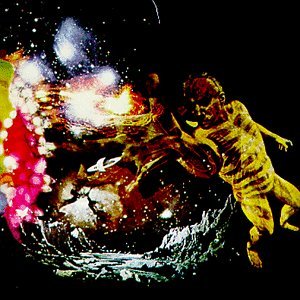
This era ended as they moved into a more jazz style with Caravanserai– the beats were less insistent and relentless and the song spaces opened up. One review I read online related the driving pulse of the first three Santana albums to the use of speed in San Francisco’s Haight-Ashbury in the late 60’s – so the band flowed with the rest of the early 70’s in mellowing the vibe as times and the drugs changed.
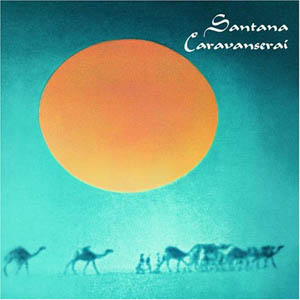
Still, maybe there’s a reason that the next jazzy cd, Welcome, was so hard to find. I’ll duck some tomatoes here, but at times I couldn’t help thinking of Spinal Tap’s infamous entry into the fusion world at their Puppet Show gig. That is, a “jazz” attitude from a powerhouse rock band can skirt the edge of a certain amount of meandering – or at least sound that way to rock listeners…
This is not to discount the Santana band’s overall stellar musicianship along with the genuine jazz pedigree of players like drummer Michael Shrieve and keyboardist Tom Coster – just to note rock’s foray into jazz was precisely the target of Spinal Tap’s parody…
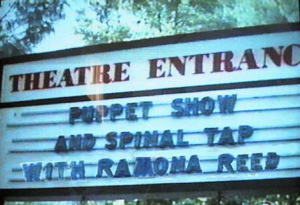
But I can respect Carlos’ (and the band’s) efforts to be free musically, emulating his hero John Coltrane (Welcome is not only titled from that Coltrane cover on the cd but Alice Coltrane herself plays on the opening track). He’s still doing his rock riffs though, and as impressive as they are, I don’t know that he breaks through sonically in the way that Coltrane does. As my percussionist friend Richard remarked, perhaps that’s why he admires him so much.
All of this, by the way, should be taken with the caveat that I certainly didn’t get to the point where I was ripping up Santana riffs like the man himself. But I was starting to notice repeating motifs and techniques – and able to approximate some of them into my own style.
And that’s where the whole thing became magical.
As I said, I first started listening to Santana back in high school – during which time they struck me as incredibly mature and exotic music. (Of course most bands at that time, like, say, Van Halen and Ted Nugent, were not offering much competition in the “mature” category). Exotic-wise, Santana songs had really cool titles like Samba Pa Ti, Europa, Savor, and Se a Cabo and Santana albums had really cool titles like Abraxas and Borboleto and Caravanserai and they all had this really cool exotic gorgeous cover art. Abraxas’s liner notes included a quote from Hermann Hesse so intense and adult and wild it seemed from outer space.
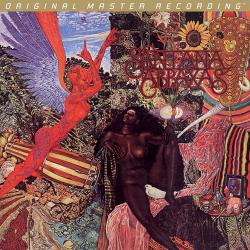
“We stood before it and began to freeze inside from the exertion. We questioned the painting, berated it, made love to it, prayed to it: We called it mother, called it whore and slut, called it our beloved, called it Abraxas….” Hermann Hesse, Demian
The music proudly waved the flag of tradition in its cultural latin roots, but it simultaneously celebrated this incredibly wailing rock guitar as a part of that. Even their mainstream hits contained loads of traditional percussion accompanied by Carlos’ signature guitar. It was like hearing youthful passion and rebellion accepted by and connected to countless older generations.
Now that last sentence gives me pause – am I just working out my own childhood parental demons here? I recall an interview in Rolling Stone in which Carlos talks about being abused as a child and how music let him transcend into a higher place. Those driving latin rhythms hit you below the belt but the sexuality is coupled (ahem…) with an overt spirituality. (You can sense their depth by watching the way a 20-year old Michael Shrieve steps up to the plate and hits it out of the park in front of 500,000 people in the Woodstock movie, his stage presence embodying what it means to become a vessel for both the music and Something Greater in a legend-making performance for both him and the band. Joyous, hell yes, but also serious and profound). Something even seemed cool about Carlos’ earnest unapologetically spiritual trip exemplified by over-the-top song/album titles like Transcendence, Mantra, All the Love in the Universe, Oneness, and Love, Devotion, Surrender.
I think you can really hear a blend of sadness and joy, urgency and effortlessness in his soaring solos. His spirituality is light and heavy at the same time, like a speeding, flying, graceful, bellowing elephant. Carlos wasn’t afraid to let it all go and aim for the peaks and that was a huge inspiration to a kid in high school, and to me now.
So when I sat at my computer at the end of the week soloing over Toussaint L’Overture– a song that a few times over the years I would have literally agreed to sell my soul to be able to play – it was…kind of a good time.
Not that I had ever even tried to play it before. But something always connected for me with Carlos. (At the risk of sounding hubristic here, I have to relate an incident about 10 years ago when someone told me they were listening to a song on the radio and when the guitar solo came on they thought “wow, finally – there’s someone who plays like Jeff” and it turned out to be…Santana). So maybe it was time for me to learn to really play like him. And, in a good way, my childhood’s end.
Although maybe that began a few years earlier, with another potentially hubristic story, when Famous Last Words finished playing an acoustic set at the Fillmore Poster Room (between sets of Robben Ford on the main stage) and the sound guy told me “guess who just watched your set?” It turned out it was Carlos – he was a surprise guest about to sit in with Robben. I watched him play his set and spoke to him briefly afterwards – he said our set was “lovely.” I commented back on his set: “wow, finally – there’s someone who plays like me…”
Just to be clear, I didn’t really say that. I also didn’t tell him I’m always telling people his 1980 solo record The Swing of Delight is one of the most underappreciated fusion albums of all time. Or that I’d more than once daydreamed about selling my soul to be able to play Toussaint L’Overture.
But I think that was all in my head as I sat at my computer that Friday night before the jam, like Bill Murray at the piano, my childhood ending with each lick of Toussaint L’Overture that came out of my axe. And my soul still owned by me.
The jam itself the next day was interesting. It turned out another guitar player did show up, but he was kind of a heavy-metal guy, and he ended up sitting out for the last hour because, as he put it, “I like what’s coming out of your amp better than what’s coming out of mine.” The keyboard player never showed, so I had to handle the organ opening of Black Magic Woman which for some reason I had figured out on guitar as I was learning the song. Part of my strategy of getting the whole big picture, I guess. But I think I really pulled the whole thing off. And most importantly, despite a few less than perfect moments, we hit some of those peaks.
And at the end we said good-bye and it was cool and let’s do it again and rode off our separate ways. And despite all the aforementioned fancy technology and the fact that we were in a fancy studio, I don’t think anything got recorded.
So what was the point of all that?
The next week, the Z-Trane Band jammed on a few of the songs at rehearsal – including a pretty interesting version of Soul Sacrifice spontaneously morphing into Bloody Knife (ah, the joys of A minor…). And I’m happy and proud that I was able to learn all those songs and can now throw some of those licks and ideas into jams, just like Carlos quotes both Coltrane’s A Love Supreme and the Doors‘ Light My Fire in his version of Soul Sacrifice on Sacred Fire.
Along these lines, it’s remarkable that most of Santana’s most popular songs are covers: Evil Ways, Oye Como Va, Black Magic Woman/Gypsy Queen, Jingo, She’s Not There. The biggest hit of his career, 1999’s Smooth was written by Rob Thomas. But Carlos knows that the point of learning someone else’s material or style is to incorporate, not copy. Then all music becomes grist for the mill. And we keep evolving. Life, as the song says on Oneness, is just a passing parade.
As I said in an earlier column, Don’t Fear the Future. (Hopefully we won’t have to stop the internet, bro). It might be the end of childhood, but now everything is coming our way.
Updated Bonus!
As I said, nothing was recorded that day, but you can click here for the JZ Band putting our own spin on a jam of Gypsy Queen>Soul Sacrifice at the end of Matter of Time. For best results, start at the 2:00 minute mark. Some nice wah and I like how it keeps building…
And you can click here for another version in a Z-Trane live video.
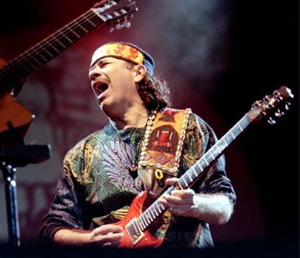
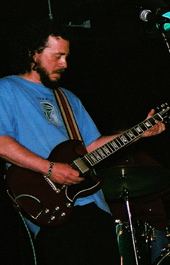
Jeff Zittrain is currently performing solo acoustic and with the Z-Trane Electric Band. He was the primary songwriter, lead guitarist and co-vocalist of the rocking yet sensitive trio Famous Last Words. He is also an activist and Humanities Professor in Berkeley, CA.
